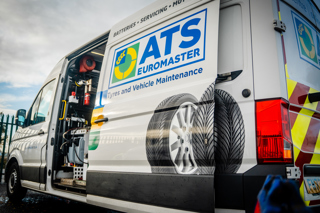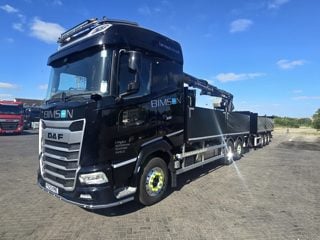Despite their critical role in the safe and cost-effective operation of a vehicle, the management of tyres is an issue often overlooked by fleet decision-makers. Instead, many are content to leave it to their leasing or maintenance provider, reducing their admin work.
But this should not be the case, says Steve Haigh, group transport manager of asbestos removal specialist Rhodar, who took tyre management out of a leasing contract in order to control it himself.
“Whenever one of my colleagues ventures on to the road, they have a patch of rubber that’s approximately three-and-a-half square inches connecting their van to the tarmac,” he says.
“In short, I want the peace of mind that comes from knowing they can always stop as quickly and safely as possible, regardless of the road conditions.
“And that’s why my preference has always been to manage the tyres that are fitted across Rhodar’s entire fleet myself rather than outsource this process to the leasing company’s maintenance contract.”
Haigh’s approach is not typical of the wider fleet sector, but more fleet decision-makers should take an active interest in their organisation’s tyres, says David Morris, fleet and business account manager at Goodyear Tyres.
“Fleets will often have company car and driver policies but, generally speaking, tyre management policies aren’t as common as they should be,” he adds.
“Tyre management policies should be afforded the same care and attention as any other health and safety document. Managers should be working in association with either a premium tyre manufacturer or respected supplier to provide one.
“It doesn’t need to include a huge amount of information, but if a business operates a fleet or provides employees with company cars, tyre management should form part of a standard company document.”
Jonathan Layton, head of fleet at Michelin, adds: “When you get it right, you can normally find that sweet spot where you are enjoying maximum performance and safety, for the lowest cost per mile.”
Here, we look at the questions a fleet decision-maker should consider when compiling a tyre management policy.

Usually, this boils down to finding the right balance between cost and safety for an individual organisation, while ensuring that tread does not wear below the legal limit of 1.6mm.
Change too early and fleets could be spending unnecessary money replacing tyres which are safe, legal and have several thousand miles of wear left in them.
Leave it too late and fleets could be using tyres which provide reduced grip in wet conditions, as well as running the risk of falling below the legal tread limit.
“Adequate tread depth is essential for good grip on wet roads as the tread pattern helps to remove water from between the tyre and the road surface,” says a spokesman for tyre safety charity TyreSafe.
“Drivers with insufficient tread depth face longer stopping distances, reduced grip and an increased risk of aquaplaning.”
It is common for fleets to change tyres when the tread falls to between 2mm and 3mm, while road safety charities TyreSafe and RoSPA (Royal Society for the Prevention of Accidents) recommend they are replaced at 3mm.
Their view is mirrored by Apollo Vredestrein UK fleet sales manager Ricky Mitchell. He says: “We suggest that while most mid-range and premium tyres are designed to perform to the end of their life – which is 1.6mm in the UK – their performance will alter as the tread depth lowers.
“Our advice would be to change fleet vehicle tyres at a tread depth of between 2mm and 3mm to avoid any possible risk of having illegal, unsafe tyres, leaving sufficient time for the unexpected.”
However, Layton says: “For us, the statutory minimum legal tread depth of 1.6mm is perfectly suited to modern motoring – especially as we know from first-hand experience with our latest generation products that tyres can be manufactured today which are safe when new and safe when worn.
“Changing a tyre at 3mm or 4mm equates to purchasing approximately one extra tyre per vehicle, every two years – and the bigger the fleet, the more that additional cost starts to add up.”
Fleets which lease their vehicles also have to consider other factors when deciding when to replace tyres, adds Gil Kelly, operations director of Venson Automotive Solutions.
He says that if a company has a policy of changing tyres when the tread is down to 2mm, and a vehicle has tyres at 2mm but is due for replacement within six months and the expected mileage is low, then it may not be prudent to replace tyres.
“Conversely, if there is a high-mileage driver who has a vehicle in for service and the tyres are at 2.2mm and the vehicle is due off contract in six months, then replacement tyres may be appropriate,” adds Kelly.

Although tyres account for almost one-third of a fleet’s maintenance budget, there are many other factors other than cost which should be taken into account when deciding what make of tyre to use, according to Jayne Pett, sales director at Fleet Operations.
“With so many brands available, it can be a minefield to decide what to go for,” she says. “If you are looking for cost efficiency, mixed with longevity and peace of mind, we would recommend running mid-range tyres.
“In the case of budget tyres, you get what you pay for: they do the job but can be something of a false economy, with lower performance and a shorter lifespan.
“We would recommend changing to budget tyres if a vehicle is due back to a funder in the forthcoming three to six months or if it has been earmarked to be sold.”
However, while budget tyres will cost less to buy, value for money should not be judged on cost alone, says Layton, which means fleets should give serious consideration to premium tyres.
He says these are unlikely to be the cheapest at point of sale because of the considerable levels of technology and research that goes into their development.
“But we are confident that the wholelife cost of a Michelin tyre, combined with long-lasting performance, reliability, low rolling resistance, safety and environmental credentials, make them an excellent option for fleets,” adds Layton.
Andy Fern, GB fleet sales director at Kwik Fit, says that the choice of budget, mid-range or premium tyres is particularly relevant to organisations which operate vans.
“There is a misconception that van fleets should adopt budget tyre policies due to the high frequency of damage. However, a quality premium van tyre is built to withstand the stresses and strains of daily use,” he adds.
“Certain premium brand van tyres are more like scaled down truck tyres as opposed to scaled up car tyres.”

In general, large fleets tend to have tyre contracts in place with leasing companies and tyre manufacturers while smaller fleets tend to deal directly with fast-fits and local independent dealers.
Nonetheless, the advice from industry experts is for each organisation to scrutinise the way it operates while simultaneously examining the size and composition of its fleet.
Mitchell says: “Choosing the best service provider and purchase option will vary between different fleets.
“If leasing vehicles with tyre maintenance included, then the leasing company will have a preferred deal with a service provider – usually one of the high street retail chains – in place.
"However, as a fleet manager, one could reserve the right to choose one’s own tyres although the leasing company is likely to specify the terms and conditions of having the vehicle back with the same brand of tyres and tread depth.
“If vehicles do not have a service agreement in place – and it’s also possible to have service agreements which exclude tyres – and tyres are being purchased by the fleet, then there’s undoubtedly more choice.
“For tyre agreements with national fleets, the service provision is still dominated by the national retailers offering a local store in all areas and consistent policy adherence.”
Mitchell adds that an alternative is for fleets to use web-based platforms – such as Fit4Fleet and the Fleet Tyre Network – which join together networks of independent tyre fitters to manage bookings, authorisations and invoicing.
“These networks may be more cost-effective or deliver a more personal service to the driver, ensuring that fleets’ tyre policies are fulfilled,” he says.
“Some tyre manufacturers are also working with service providers or networks, which then allows fleets to work with and be invoiced by the manufacturer directly.
“For smaller fleets or those based in a local or regional area they could negotiate directly with a local tyre dealer.
“Agreeing the best price and policy with a local company may very well deliver the best in terms of service levels and cost – as there are fewer people involved in the supply chain, and a local company would be keen to win regular sales.”

Fast-fits and independents are introducing an increasing number of additional services.
This can range from tyre inspections on cars and vans while they are parked at an organisation’s premises to online appointment booking, such as Kwik Fit’s Fleet Web Booking.
Fern says: “This is our solution to the ever-increasing proliferation of tyre makes, sizes and types which is making it impossible for centres to stock the thousands of tyre options available and thus makes a ‘fit first time’ visit harder to accommodate.”
Kwik Fit also has a mobile fitting service named Mobile7 which allows tyres to be fitted where the client chooses.
Earlier this year, Rhodar renewed its national service package to supply and fit Michelin tyres across its fleet of 250 light commercial vehicles with ATS Euromaster.
Under the new contract, an ATS Euromaster technician visits Rhodar’s network of depots every six weeks to carry out routine tyre inspections across the fleet, providing recommendations for remedial work to increase tyre life and protect against the likelihood of tyre-related downtime.

While the bulk of a tyre management policy will cover cost, safety and service level issues, it should also include training for employees who use company vehicles.
“This training needs to ensure a driver is consistently directed to check that they have the right tyres and that they know how to keep them in good condition,” says Morris.
“This could take the form of online awareness tests or even attended training sessions, so drivers are equipped with the knowledge required to check their tyre pressures and tread depth on a weekly basis.”

Until recently, choosing the type of tyres was not even a consideration for the majority of fleets. New cars and vans come fitted with summer tyres and, unless there was a specific safety or operational need, these would be replaced on a like-for-like basis.
Some organisations such as those in areas such as the Scottish Highlands or emergency services may traditionally have alternated between summer and winter tyres to ensure all-year round mobility, but this switch leads to extra cost and vehicle downtime.
However, the new generation of ‘all-season’ tyres, such as the Michelin CrossClimate+ and Continental AllSeasonContact, could offer fleets an appropriate all-year-round solution.
For example, Michelin says CrossClimate+’s winter performance is within 5% of its Alpine-dedicated winter tyre, but offers all the driving characteristics of a summer tyre.
One of the fleets which has adopted CrossClimate+ is South Western Ambulance Service NHS Trust, which fits it to its 200-strong fleet of Škoda Octavia rapid response vehicles.
“We only take vehicles off the road for safety inspections or maintenance, and the six-week transition period previously required to swap our summer and winter tyres twice a year was incredibly inconvenient,” says Kevin Bartholomew, fleet operations manager at the trust.
“We can now keep the same tyres on the Škodas year-round, saving time and money. Lives depend on ensuring safe mobility for our fleet, so we simply can’t afford for tyre-related downtime or lack of grip in snow, ice and rain to delay us on a call-out.”


















Login to comment
Comments
No comments have been made yet.